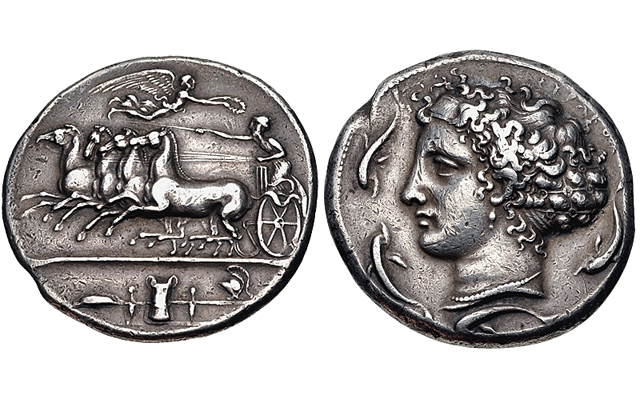
Among the vast array of ancient Greek coins, few exemplify the grandeur and artistic mastery of the Hellenistic era quite like the decadrachm. These large, silver coins, minted in various Greek city-states and kingdoms during the 5th and 4th centuries BCE, are celebrated for their impressive size, intricate designs, and historical significance. Let us delve into the allure and splendor of the Greek decadrachm, a true numismatic treasure.
A Symbol of Wealth and Power:
The Greek decadrachm, as its name suggests, was a denomination worth ten drachmas, making it one of the largest and most valuable coins of its time. Minted primarily in cities such as Syracuse, Athens, and Macedonia, these coins served not only as a medium of exchange but also as symbols of wealth, prestige, and power.
The decadrachm was often struck in high-quality silver, with meticulous attention to detail in both design and craftsmanship. Its size and weight made it impractical for everyday transactions, leading scholars to believe that it was primarily used for ceremonial purposes, such as payments to mercenaries, diplomatic gifts, or offerings to temples and deities.
Exquisite Designs and Iconography:
What sets the Greek decadrachm apart from other coins of its era is its stunning artistic imagery and iconography. The obverse typically features the portrait of a deity or ruler, rendered in exquisite detail and often surrounded by symbols of authority or divine attributes.
One of the most famous examples of the Greek decadrachm is the “Arethusa” decadrachm of Syracuse, minted during the reign of Dionysius I in the 4th century BCE. This masterpiece of numismatic art depicts the nymph Arethusa, surrounded by dolphins and wearing a wreath of grain, symbolizing the prosperity of the city’s agriculture and maritime trade.
Historical Significance:
Beyond their aesthetic beauty, Greek decadrachms offer valuable insights into the political, economic, and cultural dynamics of the ancient world. The images and inscriptions found on these coins provide clues about the rulers, deities, and events that shaped the course of history during the Hellenistic era.
For example, the coins minted by Alexander the Great feature the image of Heracles, the legendary Greek hero and symbol of strength and courage. These coins served not only to assert Alexander’s authority over his vast empire but also to reinforce his divine right to rule, as Heracles was believed to be his ancestor.
Collectibility and Legacy:
Today, Greek decadrachms are highly prized by collectors and enthusiasts for their historical significance, artistic beauty, and rarity. While many examples have been lost to the ravages of time, war, and plunder, countless specimens have survived, preserved in private collections, museums, and archaeological sites around the world.
Collectors eagerly seek out Greek decadrachms to add to their collections, with certain rare specimens commanding astronomical prices at auctions and numismatic events. However, one need not be a collector to appreciate the majesty and significance of these ancient artifacts. From their intricate designs to their rich symbolism, Greek decadrachms continue to captivate the imagination and inspire awe, serving as enduring reminders of the cultural and artistic achievements of the ancient Greeks.